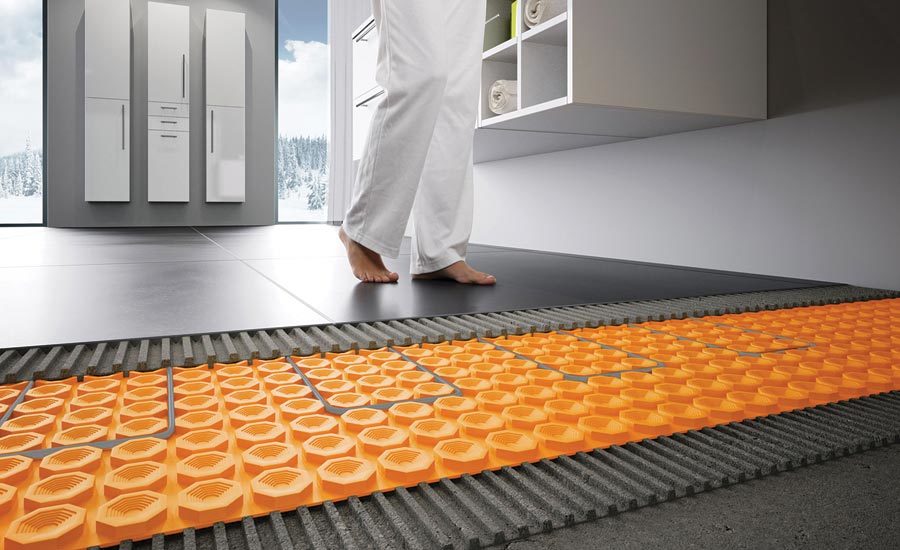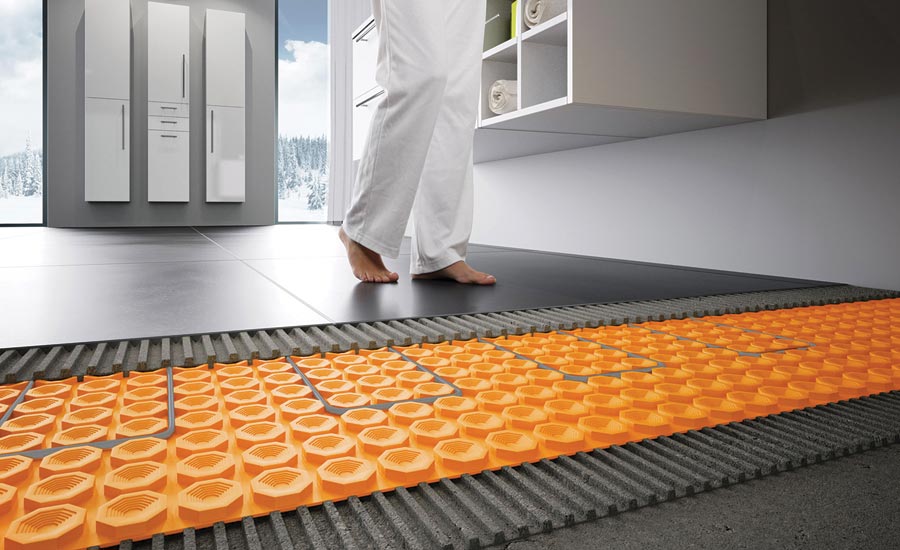Selling In-Floor Radiant Heating




Pentair’s electric floor heating system can use one or a combination of in-floor heating mats to deliver under-floor heat for the entire room.








It’s the middle of summer, and for some, radiant heating is the last thing on a customer’s mind. However, now is the perfect time to bring it to their attention—once the temperature dips, it’s going to be too late. Floor Trends spoke with manufacturers and industry experts about how to best sell in-floor radiant heating systems to consumers, and what types of systems (wire, mat, film) will suit them best.
According to Julia Billen, owner and president, WarmlyYours, most of the company’s summer sales for electric radiant heating systems are due to the fact that it’s when a lot of remodeling activity occurs. She says, “There are logistical advantages to remodeling in the summer, but it also seems like the warm weather gives people the extra energy they need to pursue their remodeling goals.”
It’s no surprise that Peter Leal, product marketing manager, Emerson, has business success in the warmer months. “[Summer] is our busiest season as [in-floor radiant heating] is installed in new home construction and renovation and remodeling jobs,” he says.
The timing of purchase and installation of these radiant systems appears to be driven primarily by remodeling timing, according to Irene Plank, marketing director, Schluter. She notes, “Although people use their systems more in the cool months, they purchase and install them when they are building or remodeling a floor, which can be at any time of year.”
Isabelle Marcil, communications coordinator, Flextherm, noted that although sales always peak in the spring (March to May), she can confirm that a quarter of Flextherm’s yearly sales occur from June to August and the numbers are matched in the fall.
Clearly, it’s not unusual to install in-floor radiant heating systems in the summer. Monica Irgens, president, Electro Plastics, made a simple, good point about in-floor radiant heating only being installed at time of home renovation. “Many remodeling projects are done in the summer and if you want in-flooring heating you will have to install it at that time.”
Selling Heat in the Summer
Marcil noticed that many individuals “shop” or search floor heating systems during the summer and ask for quotes as well. Using that information as an advantage, “We usually choose that time of the year to review our material and create content to make all necessary information easily available to them (through our website, articles as well as documentation for distributors).”
Julia Vozza, marketing manager, Loxcreen Flooring Group, focuses on marketing communications and campaigns that are focused on planning ahead and reminding people that winter will be back before we know it in order to encourage sales in the summer.
“Special promotions and discounts will also encourage sales during this time. Also, for distributors and retailers who stock these types of membranes and systems, they can be more successful in selling during the summer since floor heating may be a last-minute thing that installers and DIY’ers purchase with their tile,” she noted. “A sales associate can suggest in-floor radiant heat but if they don’t have it in stock, the customer will typically pass on the idea since they are typically picking up supplies for a renovation or job that is happening in that specific day, so there is no time to wait for a special order to come in.”
Robert Horky, accredited Bosch contractor, R.H. Hydronics/Green Heating, doesn’t see a drop in purchasing during the warmer months. “To educate our customers, we have equipped a mobile trailer with hydronic system displays to visually explain how the whole system works. This opportunity not only gives users the ability to see the product, but to also give it a try. Our show trailers pictured include the flooring and the Bosch Buderus and Condensing Boilers.”
Leal added he focuses on three channels when working to sell and feature the company’s in-floor heating products: “retail home hardware stores, electrical distribution and tile stores” are all ideal places to expose your brand and/or product.
As mentioned above, Plank said, it’s really about being ready for cooler weather, so in many cases doing the work in summer is ideal. “The room(s) can be completed for the fall and the homeowner is ready to enjoy the luxury of warmer floors underfoot when tiles might otherwise be a bit cool to the touch. The installed system allows the homeowner to feel a cooling effect from tiles in the summer when the system is turned off, and appreciate the warmth in winter when the system is turned on. It’s the best of both worlds.”
Billen expressed that selling a heating product to people during a sweltering August can sometimes feel like selling a teenager a savings bond—they might not think they want it right now, but they sure are glad they have it when the time comes. “There aren’t many bets more certain than the fact that it’s going to get cold again. So we try to remind our customers that it’s always better to have something like radiant heating installed before they really need it. Who wants to experience even one cold tile floor in the morning if they don’t have to?”
Wally Lo, Nuheat’s product manager, Pentair, also believes it’s important to emphasize to homeowners/contractors that during the time of home renovation is the best time to install in-floor heating since installation can’t occur after your floor is in.
He also mentioned some unique considerations. “We have a lot of customers with in-floor heating in warmer areas such as Southern California where they blast their air-conditioning to cool the rooms but still want their tile or marble floors to be warm to step on,” he mentioned. “We also install a lot of Nuheat in areas next to the pools because the in-floor heating helps to dry up the water so that people don’t slip. Additionally, Nuheat is great in showers as it dries the corners and grout lines to keep them clean and stop mold from forming.”
Wire, Mat or Film Systems
Application type, construction, user needs, cost and efficiency are just a few of the considerations when determining what type of in-floor radiant heating system to specify – including hydronic, air-heated and electric via mats, mesh or film.
“There are many different ways to install in-floor radiant heating,” said Horky. “It really depends on what the project circumstances are when it comes to the systems used. Crete-Heat (green flooring) has insulation value and uses ½” tubing. Fast Track (black flooring) is ½” thick and uses 5/16” tubing. If height becomes an issue, we use Fast Track because it’s much thinner than Crete-Heat.”
Irgens noted determining the type of system needed will depend on the heating needs and type of flooring: “Since the heating system is not visible, a consumer often chooses by pricing and can buy it online. Electric heating systems are available in cables, single or double; in cables on mats; in thin films, and in self-regulating PTC heaters. They are available in line voltage (120V or 240V) and in low-voltage (12V or 24V).”
Vozza stated it all depends on the application. “If you are installing in-floor radiant heat under tile, then I would always recommend using an uncoupling membrane that is compatible with heating cable systems like Prova Flex-Heat+. This will help to eliminate cracked tiles and grout caused by movement and stress on the floor/substrate. The mats and films are good to use in areas that don’t require uncoupling properties like shower bases, walls and under flooring materials other than tile like hardwood or laminate.”
Plank said there’s not necessarily a best system. “All can work well when installed. Floor thickness can be an important consideration so consumers should look at the thickness of the floor warming system they are installing. It’s easier to match the floor height to adjacent floor areas with a thinner floor warming system. It’s relatively easy to build up a thin system to match a thicker floor such as hardwood, but you can’t make a thick floor warming system thinner to match surfaces like laminate or carpet, so a thin system offers the most flexibility.”
Plank continues, “There are also some differences in the installation process. Mats come in a fixed configuration so they don’t allow for the same sort of job site flexibility as wires. If something changes in the planned layout of the room the wires can easily be reconfigured to suit those changes, but a mat cannot be changed.”
Marcil explained a mat or cable meant to be embedded in concrete is a smart choice for new constructions. “The Concrete Mat Xpress is also great for condos as it can also be covered by a 2.5 inch concrete topping.”
Emerson discussed how loose cable systems offer the most flexibility as you can wire it to any rooms specific size and get around obstacles like toilets, and they are the most economical. “Mats offer quick installations, you just have to roll the mat out and the self-adhesive sticker on the bottom adheres to the floor substrate, but is only offered in square or rectangular sizes, and costs a little more. Our Warm Tiles Elite mats are a fiber woven mat that offer ultra-thin profile (1/8”) and can be custom ordered to fit any room’s specific geometric shape, and get around obstacles like a kitchen island.”
Lo said he usually suggests mats since they have the easiest installation process. “The mats are pre-built to perfectly fit the space without any need for on-site modification – and guarantees no cold spots. The other huge benefits to mats is the thin profile, they are built like an electric blanket and only 1/8” thick. The reason this is so important is if you are redoing the tile in your bathroom next to the existing carpet/hardwood in the hallway, you need these two surfaces to be the same height where they meet.”
Last Words
Clearly, educating the customer is an important part of selling in-floor radiant heating systems, any time of year.
“The main thing that stops people from pursuing electric radiant heating isn’t the cost or the time of year—it’s a lack of familiarity,” added Billen. “Our parents never had heated floors. Our friends don’t know about them. But that’s what makes this such an exciting industry. Everyday new advances are being made, bringing us more energy-efficient products that deliver outstanding comfort. For nearly 20 years, WarmlyYours has been putting in the long hours researching and developing our expertise in this field. We’re the experts and we’re here to help.”
Lo added, “In-floor heating brings soothing comfort to any hard surface, such as tile, stone, marble and engineered/laminate wood floors, and is not just for bathroom and kitchen floors. Nuheat can heat showers and benches, stairs, countertops and even be used as the sole heat source.”
Finally, Horky mentioned that as long as the installer knows what he or she is doing, the installation is extremely beneficial for homeowners, in terms of energy efficiency and financials. He concludes, “The cost associated with the installation is only a one-time cost and the user’s energy bill reduces over time.”
Looking for a reprint of this article?
From high-res PDFs to custom plaques, order your copy today!














